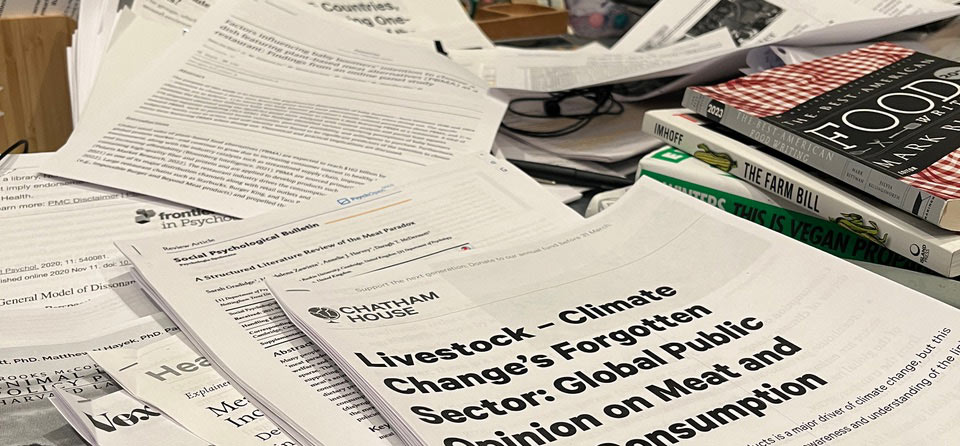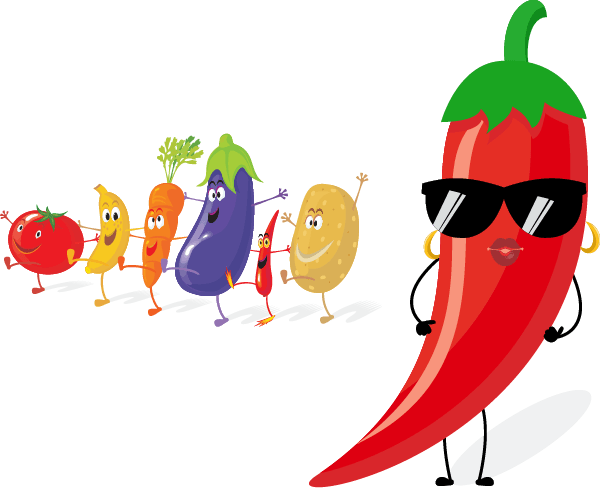
Environmental Research + Reports
A Plan to Reduce Food Waste
This Project Drawdown report finds that in countries where income is low, food waste is often unintentional, and occurs during storage or distribution. In higher income regions, food is wasted by retailers and consumers. Their plan for reducing food waste has the ability to increase food security in poor regions, and reduce greenhouse gas emissions generated from food production.
Achieving Global Climate Goals Through Plant-Based Foods
This World Resources report asks, “How can we feed the world’s 10 million people and also meet our climate goals?” The answer: Plant-based diets.
Aligning Food Systems with Climate & Biodiversity Targets
This 2022 Chatham House paper concludes that “food is a critical area in which climate change mitigation and biodiversity policies intersect.” It is the moral obligation of wealthy G7 countries, with a legacy of greenhouse gas emissions and biodiversity destruction, to align their food policies to meet international climate and biodiversity goals.
CAFOs and Their Impact on Communities
This report of the National Association of Local Boards of Health details how CAFOs, large-scale industrial farms that raise animals for meat, dairy and eggs, pollute the water and air. The 1972 Clean Water Act identified CAFOs as potential air and water pollutants, yet little has been done to mitigate their danger. Animals raised in CAFOs produce an enormous amount of manure — between 3 and 20 times the amount of manure than people produce. In the U.S., laws require human waste to be treated in sewage plants. But thanks to Big Ag lobbyists and powerful politicians from Big Ag states, the EPA (the U.S. government agency responsible for keeping our air and water safe), does not require livestock waste to be treated. EPA rejects regulating CAFOs.
Changing Climate, Changing Diets
This 2012 Chatham House report concludes that decreasing meat consumption is critical to mitigating global warming. Livestock accounts for 15% of global greenhouse gas emissions, and meat consumption is on the rise. Yet, public awareness of the link between diet and climate change is low.
Creating a Sustainable Food Future
This World Resources Institute paper investigates the positive impact on the environment if we replace all animal products with plant-based foods. As the global population and incomes grow, overall food demand will increase by more than 50 percent by 2050. Demand for animal-based foods will increase by nearly 70 percent by 2050. Yet hundreds of millions of people remain hungry. Agriculture uses almost half of the world’s land, and agriculture and food are responsible for almost 25 percent of annual greenhouse gas (GHG) emissions.
Eating to Save the Planet: Evidence from a Randomized Controlled Trial
Economic research using a randomized control trial. Researchers split student research subjects into two groups. Treatment groups received a 50-minute lecture about how food affects climate change, along with information on the health benefits of eating less meat. Control groups received a lecture on a placebo topic. Individual-level data was collected by analyzing the students’ food choices in school cafeterias. Significant dietary change resulted from the single 50-minute lecture; subjects ate less meat and more plant-based alternatives. The effect lasted through the end of the academic year.
Energy-Efficient Aquaculture
This Project Drawdown report suggests methods to reduce energy demands of aquaculture, one of the fastest growing animal food sectors. Most of the greenhouse gas emissions associated with aquaculture come from feed and transport. Switching from current petrol-based and diesel systems to more energy-efficient hybrid systems can significantly decrease greenhouse gas emissions.
Environmental Impact of Aquaculture & Capture Fishing
2018 study that unpacks the environmental cost of fisheries, livestock, and aquaculture. Mollusk (e.g., clams, oyster, mussels, etc.) aquaculture and small pelagic (e.g., anchovies, sardines, etc.) and whitefish fisheries have the lowest environmental impact. Beef and catfish aquaculture have the largest negative environmental impact.
Environmental Injustice in Maryland Chicken Farms
This National Institute of Health (NIH) study demonstrated a significant negative correlation between median income in Maryland counties and the density of pollution-creating chicken CAFOs (concentrated animal farming operations). Census tracts with larger populations of low-income people of color were disproportionally home to CAFOs, leading to health inequities and disparities.
Factors that Influence Choosing Plant-Based Menu Item at Restaurants
Many factors influence customers’ intentions to order plant-based meals from restaurant menus, including perceived health benefits, social norms, and self-identify.
Food Matters: Why Climate Change May Hinge on What we Eat
After watching this webinar, I pronounced, “That was the best webinar I’ve ever tuned in to.” And I’ve watched a lot of webinars. In one short hour, Project Drawdown explains simply, comprehensively, and understandably, why and how our food systems must change if we care about saving the planet.
How Concentrated Animal Feeding Operations (CAFOs) Impact Communities
A pressing public health issue associated with CAFOs comes from the amount of manure they produce; it can contain E. coli, growth hormones, antibiotics, chemicals used to clean equipment, animal blood, copper sulfate, and more. These contaminants pollute the water and air. Though sewage treatments are required for human waste, they are not required for animal waste.
Livestock – Climate Change’s Forgotten Sector
This 2014 report by British think-tank Chatham House, concludes that shifting demand for meat and dairy to plant-based foods is central to achieving our global climate goals. Yet, governments and NGOs are reluctant to undertake policies and campaigns that shift consumer demand away from animal-based foods. The report explores why. Ten years after the report was published, there is still little public awareness of the link between food and climate change.
Livestock Industry’s PR Campaign to Muddy the Truth
Soon after the 2006 UN report, “Livestock’s Long Shadow,” provided the first estimate of livestock’s role in climate change, Big Ag launched a massive PR campaign, taken from Big Tobacco’s playbook, obfuscating the truth by funding “research.”
Livestock’s Long Shadow: Environmental Issues and Options
When the U.N. released this report in 2006, it was the most comprehensive assessment of the devastating impact of animal agriculture on the environment to date. Of particular concern: land and water pollution, and land degradation from over-grazing and livestock-induced deforestation. The report was a call to action, to “encourage decisive measures at technical and political levels” to mitigate the damage. Rather than spur positive change, it unleashed a firestorm of controversy and an army of lobbyists, funded by Big Ag. The dire situation painted by the U.N. in 2006 has worsened; meat consumption is on course to double by 2050.
Manure Management Techniques to Reduce Pollution
This Project Drawdown report suggests two methods to reduce greenhouse gas emissions from cattle and hog farms. Both are simple. Reduce the amount of time the manure is stored, and cover open-air lagoons.
Meat Worse for Environment than Numbers Say
This World Resources report asks, “How can we feed the world’s 10 million people and also meet our climate goals?” The answer: Plant-based diets.
Meat-Related Cognitive Dissonance
Many meat eaters love animals, yet continue to eat them. Cognitive dissonance theory explains how it’s possible for people to rationalize behaviors at odds with our attitudes.
Paris-Compliant Livestock Sector
Released in 2024, this comprehensive Harvard Law School Animal Law & Policy Program report provides timeframes, targets, and trajectories for livestock sector emissions, based on a survey of 200+ climate scientists. To align with the Paris Agreement, scientists conclude that human diets must shift from meat to plant-based foods. Global emissions from livestock production must decline by 50% by 2030.
Plant-based Meat and Milk Alternatives Help Achieve Climate Goals
Shifting from dairy milk and meat to plant-based meat and milk alternatives can significantly halt the destruction of forests and natural lands and decrease greenhouse gas emissions.
Plant-Rich Diets Decrease Greenhouse Gas Emissions
You don’t need to eat 100% plant-based food to decrease your FoodPrint. This Project Drawdown report demonstrates how “plant-rich” diets can reduce demand for animal products, thereby reducing land clearing, fertilizer use, and greenhouse gas emissions.
Putting Meat on the Table: Industrial Farm Animal Production
This 2008 report by the Pew Commission concludes our current system of food production creates an unacceptable level of risk to public health, damage to the environment, and leads to vast amounts of unnecessary animal suffering. The authors found researching the topic of animal agriculture (mostly animals raised in mega-industrial farms, or CAFOs) extremely difficult, due the power of an agro-industrial complex, an alliance of agriculture trade groups, academics whose research is funded by Big Ag corporations, and legislators who are friendly to Big Ag manufacturers in their states.
Rationalizing Meat Consumption: Natural, Normal, Necessary, Nice
Empirical research on how omnivores “defend” decision to eat meat, even when it is inconsistent with their attitudes towards animal welfare.
Reviewing Interventions for Healthy & Sustainable Diets
What’s good for our health is good for the environment. This paper details and reviews interventions that work as incentives for people to replace animal-based products with plant-based foods.
The Harvard Planetary Health Diet
2024 large-scale study by Harvard School of Public Health demonstrates that diets best for our health are also those that are best for the planet.

